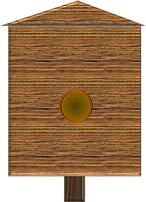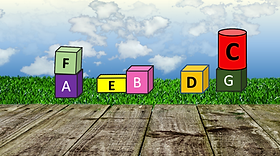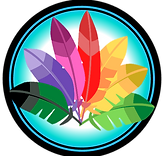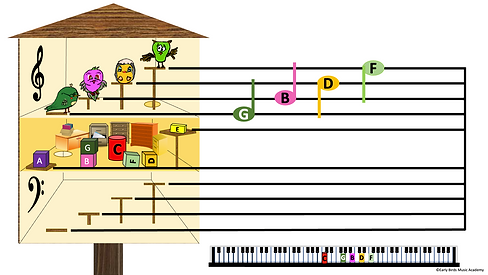






About Early Birds Music Academy
The Full Story



My name is Corinne and I qualified as a primary school teacher in 1994 from the University of Northumbria. Being passionate about music since hugging the speakers in the living room at the age of three, I was fortunate to be able to specialise in teaching music at my children's own school, Fern Hill Primary School in SW London. It was an opportunity I will always be grateful for at this consistently outstanding establishment.
I had the idea about teaching notes of the stave with The Note Birds in 2014 whilst using boomwhacker note tubes in class. The idea grew and the storyline became more settled as time passed. The Note Birds are now as well known to me as my best friends. I hope that by introducing them to young musicians (or anyone keen to understand music), the pure joy of playing an instrument will be less of a leap in learning.
Other courses that are in line with the academy's mission are planned. Look out for Sliding to Success, a 12 day course that helps musicians who struggle with vocal pitching to find their singing voice. Also, a pedalling course that teaches piano students to coordinate their foot for a more satisfying and quality sound will shortly be available on the academy platform.
The Colourful World of The Note Birds
Making sense of notation is off-putting for so many children and adults wanting to play music! Learning to play and instrument requires a masters degree in multi-tasking, or at least an ocean's worth of patience and so many people find note deciphering the biggest and most annoying stumbling block. If this sounds like you, your child or student, let's remove the issue so you can move forward without the brain strain!
This solution demystifies note reading quickly and effortlessly. There is, of course,
learning and practice involved but there are three easy steps to get to grips with and that's it. No more mnemonic confusion, no more frustration. The interactive modules, each up to ten minutes long, are aimed for any age from 5.
Beginners can learn the system to start their journey and then use it as they go, with
any method book, more able to focus on other aspects of their journey and more importantly - the sounds they are enjoying!!
One easy rhyme
Engaging
Interactive
Faster progress
Any up-to-date touch screen.
Three chapters
Any operating system
Satisfying
Certificates and
badges to collect

Musical Notes are EASY with The Note Birds
The Story
Piano diagrams are displayed most of the way through to help orient and play the notes being learned if needed.


There are two bird houses on opposite sides of the garden. On one side live the Line birds and on the other live the Space Birds. The Space Birds have a new and very modern house.
These houses have three rooms. The high room (treble) and low room (bass) both have special places for each bird to sit and we can imagine these places extending out as a way to make
the musical staff less abstract.
We must always think of the birds in their special order and remember where they sit. The middle room is like an entrance hallway and the Note Birds keep their belongings there (including some very special boxes with music in)




First, we meet the Line Birds in their house. We see how their three rooms help us make sense of the musical stave including the high notes, the low notes and the lines.
We get to know them and their special order and are shown that by knowing their names in order, straight away, we can name 8 notes of the stave. There are practice modules and badges to collect, followed by a quiz and a certificate.


Next, we visit the Space Birds in their new house and notice that
their middle room is very empty apart from a few boxes strewn around. Otherwise it is organised in a similar way to the Line Bird's house. We are shown how their places in the high and low room can help us know the notes A, C and E using their special order.
We get to know the Space Birds and find out that the Line Birds have been looking after all the boxes. And because the boxes represent the lines and spaces the opposite way round, the Line Birds keep the line boxes A, C and E. The Space Birds keep the
space boxes G, B, D and F.
We help Cory collect them and when we return we see the house has been unpacked. So now, we can name the Line Birds' eight AND the Space Birds' six. Fourteen notes are now readable. There are practice modules and optional games with badges to collect, followed by a quiz and a certificate.




Finally, we focus our attention on the middle rooms of both houses to get know the notes around middle C using the same note bird order but with their boxes which now makes sense since the Space Birds have
settled into their new house.
The activity modules, games and quiz complete the learning of all 21 notes from the lowest line to the highest with all the spaces in-between.
There is one last short chapter with a quick reflection to bring it all together. A final quiz completes the course.


Mission
The mission of The Academy is to demystify some of the more inaccessible aspects of musicianship.
In a user-friendly way, and in easy steps, we seek to encourage musical potential by bringing out the inner musician with our courses.


